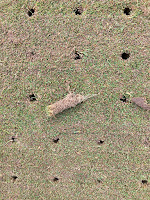It was that time of year again where I made my annual visit to the University of Missouri Turf Field Day. I always feel it is important to support the work that these fine researchers are doing, but also it is my duty to my employer, our customers, my fellow colleagues and coworkers, and myself, to find out what avenues to better conditions might be available to us in the future. As always I wasn't disappointed.
Probably the most intriguing research I am looking forward to seeing the end results for, is, "Advancing our Knowledge of Soil Hydrophobicity and Use of Wetting Agents". It is a USGA sponsored research project and what I find interesting is one of the items they will be looking at closely is the different particle sizes and how the different wetting agents react to them.
They have started the research by taking soil samples from 3 different sites/greens that meet the USGA guidelines for particle size, yet have found that while meeting USGA guidelines, each location was different. One site had more course soil particles, while another site had a much higher percentage of fine particles. They will be looking how each of the different wetting agents in the study react to those particles size differences. Usually we ask our fellow superintendents what wetting agent they are using, and then we try it out for ourselves. This study might show the fallacy of that approach, unless we are to have the same soil structure. I can see in the future, we will have a better idea of what wetting agent is going to work the best for us due to our soil structure and also depending on what our needs are at that time, such as a seasonal basis. Do we want to use a penetrant to push our water down through the soil, such as during the rainy season? Do we switch up to a retention type wetting agent during the drier summer months? All ideas that I find very interesting, and the answers might provide the best use of our dollars, while providing the best playing conditions during the season.
One of the other stops that I felt of some great interest had more to do with sports fields, but it had me think about possible uses in golf. The research was titled, "Implementing the 'Bluemuda' Concept of Sports Fields for Zoysiagrass use." The research was just started this year on plots that had previously been inoculated with Large Patch, a problem in zoysia that we will see on golf courses as well. The introduction of the Bluegrass into the warm season grasses as I understood it was to help hide the disease issues as the warm season grass came out of dormancy. The other benefit is helping fields have better playing surfaces in the early spring and late fall, while the warm season grasses are coming out or entering into dormancy, I imagine this could be helpful in small heavy traffic areas such as small tees or driving range tees. Also part of the research is a new mowing procedure for warm season turf called Fraze mowing which removes a lot of the thatch from the top layer of warm season grass. I don't see much use of it for golf courses, but in sports fields where there is some down time, research seems promising.

I picked up some tips to help improve our native landscapes to help support butterflies, native pollinators, and bird habitat. I also showed pictures of our wildflower areas and received some positive feedback. It just takes some time and patience .
I also checked out even if it was just for pictures what ornamentals were thriving this year in the summer heat.


These Pepper Flowers were pretty interesting. 

As always a great day spent learning and networking with colleagues. While sometimes the research doesn't address each and every situation or issues we deal with on a daily basis, never the less, it does encourage critical thinking and experimentation on our end. Hopefully they will continue to receive support from our green industry and state lawmakers. Research is a huge benefit to our industry.
Hope you enjoyed reading.
Thanks!
Mel




































